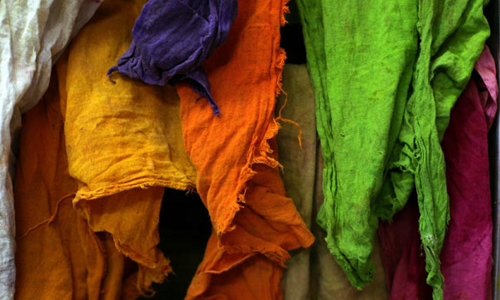
A big fashion carbon footprint

Eileen Fisher, a clothing industry magnate, known for her commitmentfast fashion 1 to environmental causes explains fashion is a complicated business that involves a long and varied supply chain, raw material, textile manufacture, clothing construction, shipping, retail, use and ultimate disposal of the garment. Fashion carbon footprint is huge and a assessing how much it is, by itself is an overwhelming task. A general assessment needs to take into account the obvious pollutants like pesticides used in cotton farming, toxic dyes used in manufacturing and great amount of waste discarded clothing creates while also looking at the extravagant amount of natural resources used in extraction, farming, harvesting, processing, manufacturing and shipping.
Cotton, and especially organic cotton can consume more than 5,000 gallons of water to manufacture a T-shirt and a pair of jeans. On the other hand, synthetic, man-made fibres, may not use so much water, but often have issues with manufacturing pollution and sustainability. Also, across all textiles, the manufacturing and dyeing of fabrics is chemically intensive.
Moreover, globalisation means a garment has been across the globe in a container ship running on the dirtiest of fossil fuels. Besides, the current trend in fashion retail creates a great demand for quick and cheap clothes, which is another big issue. After purchase too, your clothes pose a threat to the environment from washing and final disposal when you’re finished with the garment may cause more harm to the planet than one realises.
Dyes too are harmful as they create a chemical Fukushima in Indonesia and the Citarum River is considered one of the most polluted rivers in the world, partly because of the textile factories lined up on its shores. With 68 per cent of the industrial facilities on the Upper Citarum producing textiles, the adverse health effects on five million people living in the river basin and wildlife are alarming, as per Greenpeace.
More than 60 per cent world clothing is manufactured in developing countries although, majority of the world’s apparel conglomerates are US-based. Asia produces more than 32 per cent of the world’s supply, making it a major exporter of clothing. The leading producer and supplier is China, and comprises nearly 13 per cent of the world’s exports.
Overhaul need of hour
Clothing companies are moving to countries where manufacturing is cheaper, as production and labour costs are on the rise in China. Countries like Bangladesh, Vietnam, Pakistan and the Philippines are where manufacturing happens, but they do not have the raw materials, which is most often shipped from countries such as India, China, and the US. Once manufactured, the garments are sent by rail, container ships and eventually rail and trucks to the retailer. Loads of fuel is used to ship these garments across the world.
Realising the impact on environment, some designers are refurbishing the fashion industry. For example, Fisher’s company is already using 84 per cent organic cotton, 68 per cent organic linen and uses less water and carbon emissions and is working to make its supply chain sustainable by 2020. But as Fisher said, hers is just one company and the impact is rather small. The real change would come about when big, affordable brands start selling sustainable clothing.












